A) (a)
B) (b)
C) (c)
D) (d)
E) (b) and (d)
G) C) and D)
Correct Answer

verified
Correct Answer
verified
Multiple Choice
Use the figure below to answer the following question.
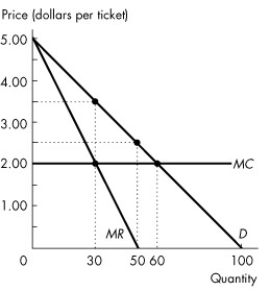 Figure 13.4.2
-Refer to Figure 13.4.2.Assume this monopolist practises perfect price discrimination.How many tickets are sold?
Figure 13.4.2
-Refer to Figure 13.4.2.Assume this monopolist practises perfect price discrimination.How many tickets are sold?
A) 20 tickets
B) 60 tickets
C) 40 tickets
D) 100 tickets
E) 80 tickets
G) A) and D)
Correct Answer

verified
Correct Answer
verified
Multiple Choice
Canada Post has a monopoly on residential mail delivery.Pfizer Inc.makes LIPITOR,a prescription drug that lowers cholesterol.Rogers Communications is the sole provider of cable television service in some parts of Ontario.The monopolies which are legal monopolies are ________.
A) only Pfizer
B) Canada Post, Pfizer, and Rogers Communications
C) Canada Post and Pfizer
D) only Canada Post
E) none of the above
G) B) and E)
Correct Answer

verified
Correct Answer
verified
Multiple Choice
Use the figure below to answer the following questions.
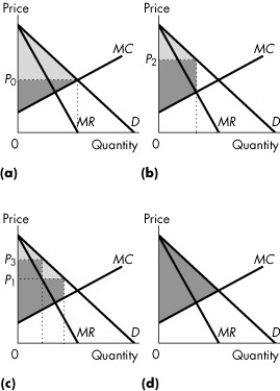 Figure 13.4.4
-Refer to Figure 13.4.4.Consider a market with a perfect price-discriminating monopolist.If the light grey area shows the consumer surplus and the dark grey area shows the producer surplus,which graph correctly represents this firm?
Figure 13.4.4
-Refer to Figure 13.4.4.Consider a market with a perfect price-discriminating monopolist.If the light grey area shows the consumer surplus and the dark grey area shows the producer surplus,which graph correctly represents this firm?
A) (a)
B) (b)
C) (c)
D) (d)
E) none of the graphs
G) B) and D)
Correct Answer

verified
Correct Answer
verified
Multiple Choice
Suppose in an industry a firm realizes economies of scale over the entire length of its LRAC curve.In this situation,the firm is
A) a natural monopoly.
B) a fixed-cost monopoly.
C) an output-discriminating monopoly.
D) a perfect-price discriminating monopoly.
E) a constant total variable cost monopoly.
G) A) and E)
Correct Answer

verified
Correct Answer
verified
Multiple Choice
Which one of the following is true for a single-price monopolist but not for a perfectly competitive firm?
A) The firm maximizes profit by setting marginal cost equal to marginal revenue.
B) The firm is a price-taker.
C) The firm can sell any level of output at any price it sets.
D) The firm's marginal cost is less than price.
E) The firm's marginal revenue curve is horizontal.
G) B) and E)
Correct Answer

verified
Correct Answer
verified
Multiple Choice
One difference between perfectly competitive markets and a single-price monopoly is that
A) marginal revenue equals marginal cost for perfectly competitive firms, but not for single-price monopolists.
B) marginal cost equals average variable cost for perfectly competitive firms but not for single-price monopolists.
C) price equals minimum average total cost for single-price monopolists but not for perfectly competitive firms.
D) marginal revenue equals price for perfectly competitive firms, but not for single-price monopolists.
E) none of the above
G) None of the above
Correct Answer

verified
Correct Answer
verified
Multiple Choice
Use the figure below to answer the following questions.
 Figure 13.3.3
-Consider the revenue and cost curves in Figure 13.3.3.What is the difference in consumer surplus between a single-price monopoly and a perfectly competitive market?
Figure 13.3.3
-Consider the revenue and cost curves in Figure 13.3.3.What is the difference in consumer surplus between a single-price monopoly and a perfectly competitive market?
A) EADH
B) EABH
C) ABD
D) ACD
E) FHDC
G) A) and D)
Correct Answer

verified
Correct Answer
verified
Multiple Choice
Use the table below to answer the following question.
Table 13.2.1
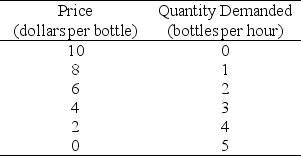 -Refer to Table 13.2.1.Minnie's Mineral Springs,a single-price monopoly,faces the market demand schedule given in the table.Minnie will not produce a quantity at which the market demand for water is inelastic because when demand is inelastic she can ________ the quantity produced,which ________.
-Refer to Table 13.2.1.Minnie's Mineral Springs,a single-price monopoly,faces the market demand schedule given in the table.Minnie will not produce a quantity at which the market demand for water is inelastic because when demand is inelastic she can ________ the quantity produced,which ________.
A) increase;increases total revenue, decreases total cost, and increases economic profit
B) increase;increases total revenue and increases total cost, but the increase in total cost is less than the increase in total revenue
C) decrease;increases total revenue, decreases total cost, and increases economic profit
D) decrease;decreases total revenue and decreases total cost, but the decrease in total cost is less than the decrease in total revenue
E) decrease;increases total revenue, does not change total cost, and increases economic profit
G) D) and E)
Correct Answer

verified
Correct Answer
verified
Multiple Choice
Use the information below to answer the following questions.
Fact 13.5.1
Cascade Springs Inc.is a natural monopoly that bottles water from a spring high in the Rocky Mountains.The total fixed cost it incurs is $80,000, and its marginal cost is 10 cents a bottle.The demand curve for Cascade Springs bottled water is shown in the following figure:
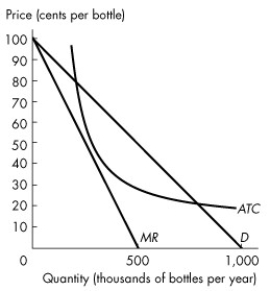 Figure 13.5.1
-Refer to Figure 13.5.1.Suppose the firm is regulated by the government that imposes marginal cost pricing.The price of a bottle of water is
Figure 13.5.1
-Refer to Figure 13.5.1.Suppose the firm is regulated by the government that imposes marginal cost pricing.The price of a bottle of water is
A) $0.
B) $0.50.
C) $0.30.
D) $0.10.
E) $0.20.
G) D) and E)
Correct Answer

verified
Correct Answer
verified
Multiple Choice
Taking competitive rent seeking activity into account,the social cost of monopoly is equal to the
A) deadweight loss from monopoly.
B) monopoly's producer surplus.
C) deadweight loss plus the monopoly's producer surplus.
D) deadweight loss minus the monopoly's producer surplus.
E) consumer surplus lost plus producer surplus lost.
G) C) and E)
Correct Answer

verified
Correct Answer
verified
Multiple Choice
Use the figure below to answer the following questions.
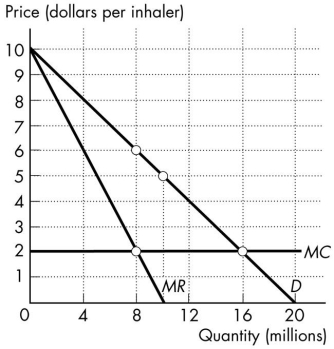 Figure 13.4.6
-Prime Pharmaceuticals has developed a new asthma medicine,for which it has a patent.An inhaler can be produced at a constant marginal cost of $2 per inhaler.The demand curve,marginal revenue curve,and marginal cost curve for this new asthma inhaler are shown in Figure 13.4.6.The patent gives Prime Pharmaceuticals a monopoly for its new inhaler.If Prime Pharmaceuticals can perfectly price discriminate,then consumer surplus is
Figure 13.4.6
-Prime Pharmaceuticals has developed a new asthma medicine,for which it has a patent.An inhaler can be produced at a constant marginal cost of $2 per inhaler.The demand curve,marginal revenue curve,and marginal cost curve for this new asthma inhaler are shown in Figure 13.4.6.The patent gives Prime Pharmaceuticals a monopoly for its new inhaler.If Prime Pharmaceuticals can perfectly price discriminate,then consumer surplus is
A) zero.
B) $24 million.
C) $64 million.
D) $44 million.
E) $32 million.
G) A) and C)
Correct Answer

verified
Correct Answer
verified
Multiple Choice
A price cap is a price ________.A price cap might be a more effective way of regulating monopoly than rate of return regulation because under rate of return regulation ________.
A) ceiling;a firm incurs an economic loss
B) floor;price is set equal to marginal cost
C) ceiling;the firm's managers have an incentive to inflate costs
D) floor;the firm's managers have an incentive to purchase more than the efficient quantity of capital
E) floor;the firm's managers have an incentive to inflate costs
G) C) and D)
Correct Answer

verified
Correct Answer
verified
Multiple Choice
The more perfectly a monopoly can price discriminate,the
A) smaller its output and the lower its profit.
B) smaller its output and the higher its profit.
C) larger its output and the lower its profit.
D) larger its output and the higher its profit.
E) none of the above.
G) B) and D)
Correct Answer

verified
Correct Answer
verified
Multiple Choice
Use the figure below to answer the following questions.
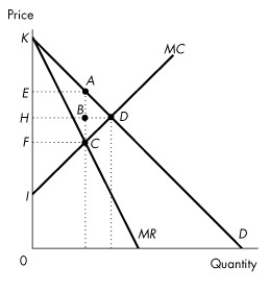 Figure 13.4.5
-Refer to Figure 13.4.5.What is the redistribution of surplus from consumers to the producer with a perfect price-discriminating monopoly,as compared to a perfectly competitive market?
Figure 13.4.5
-Refer to Figure 13.4.5.What is the redistribution of surplus from consumers to the producer with a perfect price-discriminating monopoly,as compared to a perfectly competitive market?
A) EADH
B) EABH
C) ABD
D) ACD
E) KHD
G) A) and C)
Correct Answer

verified
Correct Answer
verified
Multiple Choice
Use the figure below to answer the following question.
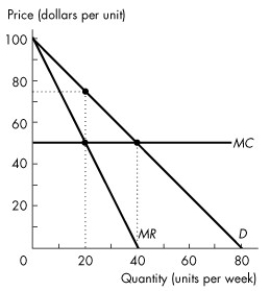 Figure 13.4.3
-Refer to Figure 13.4.3.The outcome is efficient if
Figure 13.4.3
-Refer to Figure 13.4.3.The outcome is efficient if
A) the monopoly is able to perfectly price discriminate.
B) the price consumers pay is equal to average total cost.
C) the price consumers pay exceeds minimum average variable cost.
D) the quantity produced is 80 units.
E) the quantity produced is 20 units.
G) B) and E)
Correct Answer

verified
Correct Answer
verified
Multiple Choice
Use the figure below to answer the following questions.
 Figure 13.3.3
-Consider the market demand curve in Figure 13.3.3.If the market is perfectly competitive,which area indicates producer surplus?
Figure 13.3.3
-Consider the market demand curve in Figure 13.3.3.If the market is perfectly competitive,which area indicates producer surplus?
A) AEK
B) DHK
C) DIK
D) DIH
E) None of the above.
G) B) and D)
Correct Answer

verified
Correct Answer
verified
Multiple Choice
Use the figure below to answer the following question.
 Figure 13.4.2
-Refer to Figure 13.4.2.Assume this monopolist practises perfect price discrimination.What is the lowest price charged for tickets?
Figure 13.4.2
-Refer to Figure 13.4.2.Assume this monopolist practises perfect price discrimination.What is the lowest price charged for tickets?
A) $0
B) $1.00
C) $3.50
D) $3.00
E) $2.00
G) B) and D)
Correct Answer

verified
Correct Answer
verified
Multiple Choice
Use the figure below to answer the following questions.
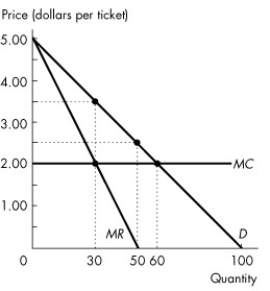 Figure 13.2.3
-Refer to Figure 13.2.3.Assume this firm is a single-price monopoly.How many tickets does this monopolist sell to maximize economic profit?
Figure 13.2.3
-Refer to Figure 13.2.3.Assume this firm is a single-price monopoly.How many tickets does this monopolist sell to maximize economic profit?
A) 20 tickets
B) 30 tickets
C) 50 tickets
D) 60 tickets
E) 100 tickets
G) C) and D)
Correct Answer

verified
Correct Answer
verified
Multiple Choice
When a monopoly practices price discrimination ________.
A) it charges different prices to different consumers and transfers some of the consumer surplus to economic profit
B) it produces a smaller quantity than when it is a single-price monopoly which decreases consumer surplus
C) new firms enter the industry, so buyers have more goods from which to choose and consumer surplus increases
D) consumer surplus increases because the monopoly increases the quantity available for sale
E) firms exit the industry and consumer surplus decreases
G) C) and D)
Correct Answer

verified
Correct Answer
verified
Showing 81 - 100 of 107
Related Exams